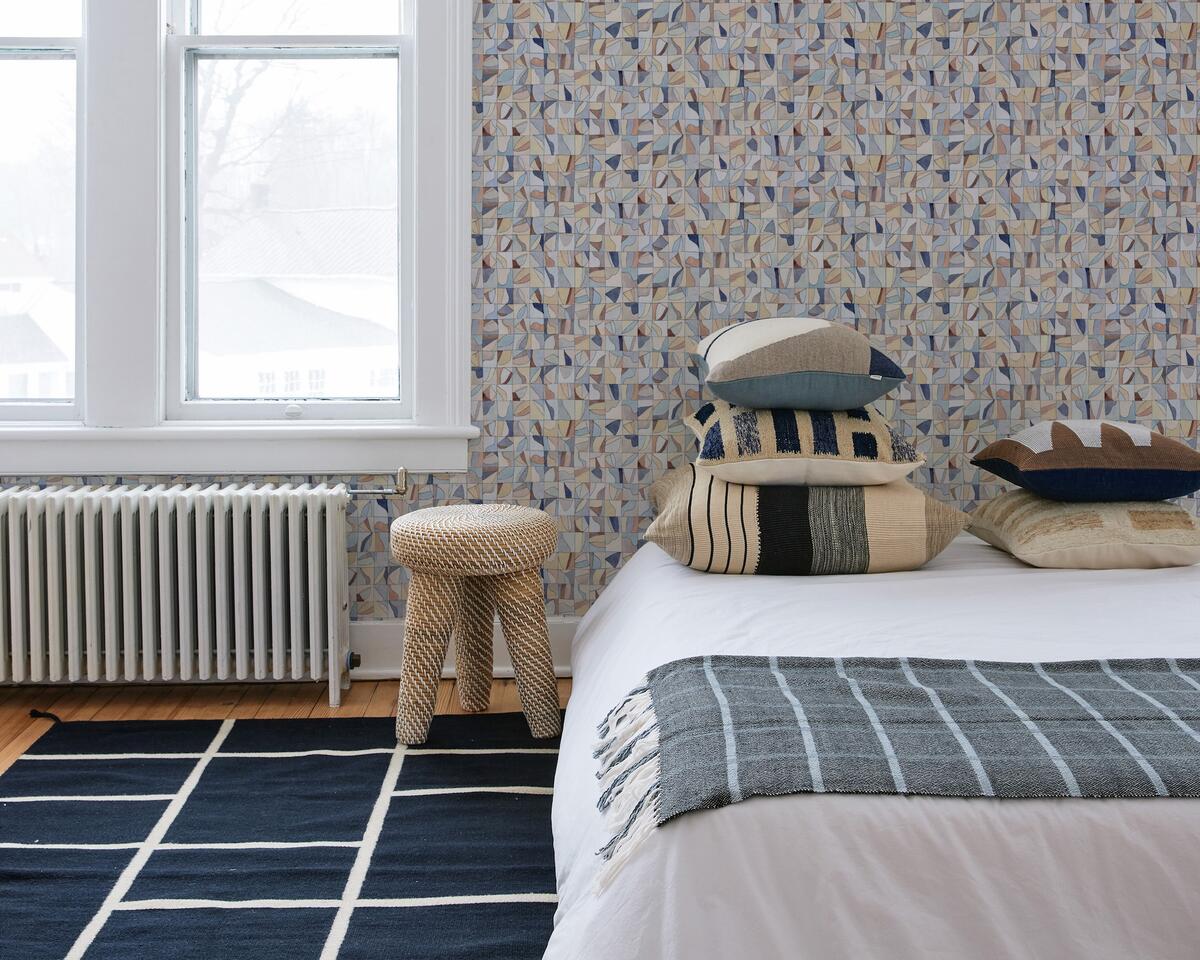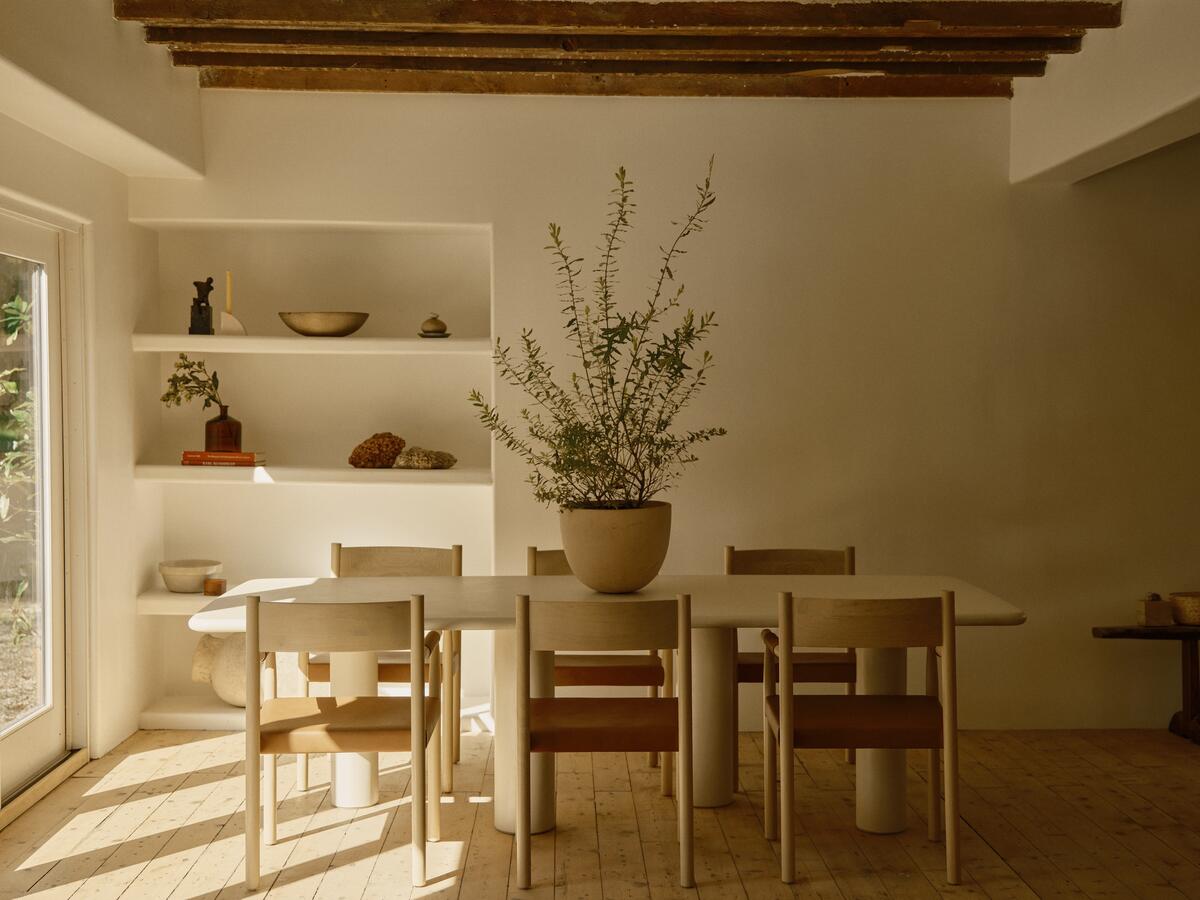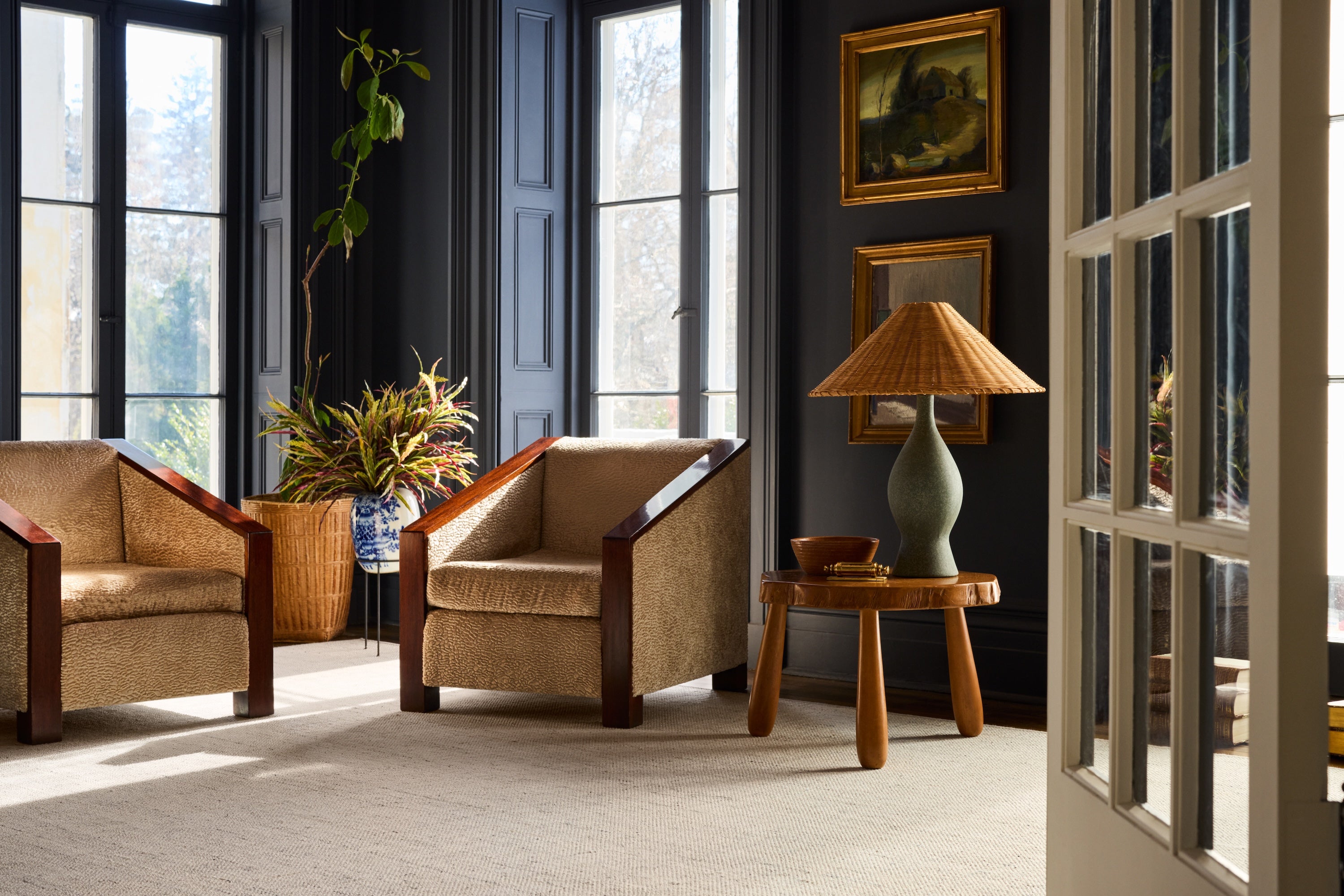If you went back in time and looked at Minna’s website in 2013, you’d see more or less the same things you see there today: Beautiful, understated home textiles, largely made by artisan makers in Central and South America. A decade later, the basic idea driving the product hasn’t changed. Behind the scenes, everything has.
Minna was founded by Sara Berks, a former graphic designer who built the company on the road, linking an artisan supply chain together by foot, bus, boat and plane. Like a lot of entrepreneurs, she started off thinking she’d be selling to people like herself—creatively inclined millennials splurging on a nice pillow or rug for their home. She sold DTC, eventually opened a shop in the Hudson Valley and developed a network of wholesale buyers, including Design Within Reach. Designers shopped Minna, but they weren’t her focus.
Over time, that began to change. Berks started to see interest from the trade steadily grow, while the rest of Minna’s business seemed to be riding a crazy roller coaster, especially during the pandemic. The early days of Covid shutdowns crushed wholesale orders, but after the brand began selling masks through its website, its DTC business took off—only to drop again after the home boom eased up.
Amid those ups and downs, Berks had also begun to discover that, in fact, she was not her customer; if she wanted to pay artisans a fair rate for their work, the product could not be priced at a bargain. “It’s been a process of getting comfortable with the fact that in order to have a successful business that’s making things in a fair, ethical, sustainable way, we have to sell to the affluent,” she says. “[We realized] that the customer is a little older, likely owns their own home, maybe has a second home, and could afford an interior designer.”
Last year, she began developing a wallpaper and fabric line that debuted this spring. This summer, she shuttered her store in Hudson. The brand will still sell DTC, and Berks hasn’t dropped her wholesale accounts, but these days, rather than spending all her time trying to game Meta’s and Google’s ad systems, she’s reaching out to design firms directly. Simply put: Minna is pivoting to the trade. In that, Berks is not alone.
THE RISE OF THE DESIGNER
Designers have always been great customers, if somewhat mysterious to those outside the trade. When you’re in the middle of the design industry, it’s easy to forget that many people don’t know it exists—even some of the entrepreneurs who start home brands. In the era of VC-funded direct-to-consumer startups that swarmed the late 2010s, it was common to chat with a founder who would happily admit they hadn’t remotely considered designers as a customer base until they started buying the product.
For those who know, the appeal is obvious. The average consumer only buys a few sofas across the span of their entire life; designers buy them monthly. The average consumer is more likely to return bulky furniture and be price-obsessed; designers are savvy buyers and quality-obsessed. Finally there’s the marketing component: When a brand sells to a designer, they’re often reaching thousands of Instagram followers too. If your product is a hit with the trade, it’s likely going to penetrate the broader market eventually.
“What we’ve realized is that if you make the trade happy, very quickly the consumers are going to want those SKUs too,” says John Foley, the founder of custom rug startup Ernesta. Foley, the former CEO of Peloton, launched the brand last year on the back of a $25 million fundraise (potentially the last big venture check to be written for a DTC home brand for some time). Though he always had designers in mind as potential customers, he has been surprised by the degree to which the brand’s growth has been driven by the trade—it currently makes up roughly a quarter of Ernesta’s business, and he says it could one day be up to half.
“[Consumers] need more hand holding, and they don’t necessarily have the confidence to buy a $2,000 rug on the internet. They need mockups, renderings, and sometimes it takes three or four months for them to pull the trigger,” says Foley. “The consumer part of our business is about educating the marketplace about custom. Interior designers, by an order of magnitude more, understand custom already.”

On the other side of that opportunity are expenses and limitations. To attract designers, consumer-facing brands usually have to offer trade pricing, which cuts into their own margins. Luring designers can also require staffing up and branching out into new categories—all of which adds up. Then there’s the simple fact that, despite how rarely consumers buy home furnishings, there are a lot more of them than there are designers (tens of millions versus tens of thousands). The trade is powerful, but it’s only so big. For that reason, many brands will take the initial step of setting up a trade program, but do little to promote or grow it.
In recent years, a few changes to the industry have tipped the balance toward making the opportunity far greater than the cost of reaching designers. One has been happening slowly over the past two decades. The other has been accelerating quickly for the past two years.
On the longer time horizon, ever since the turn of the millennium, designers have been gaining cultural power via HGTV, Instagram and Pinterest, while traditional mom-and-pop furniture stores have been dying off in droves (just this week, a Philadelphia institution closed its doors). As a result, the manufacturers and wholesalers who rely on furniture stores to move their goods have been struggling to figure out who to sell to, and designers have been the obvious answer. Witness the shifting demographics of High Point Market—once a trade show for retail buyers, now a mini festival for designers.
The same appeal applies to so-called lifestyle retailers—brands like Crate & Barrel, Pottery Barn, CB2, West Elm, Arhaus and RH—which all began courting the trade in earnest in the 2000s. They were savvy enough to realize that the design industry had grown beyond a rarefied profession and into a service that a huge population—there are 22 million millionaires in America—could afford. All of those brands have trade programs now.
“The lifestyle retailers are all going after designers—partly because, with the decline of the independent furniture retailing channel, shoppers feel more comfortable working with designers,” says Warren Shoulberg, a veteran industry journalist and Business of Home’s retail columnist. “At the wholesale level, look at the expansion of access for designers from the showrooms. They used to be banned; now vendors are putting out mimosas for the trade.”
There have been so many tailwinds at the design industry’s back, even raw demographics. Millennials, maybe the most aesthetics-obsessed generation, are coming of age into their family-raising and homebuying years in an era when both spouses typically work—meaning no one has time to decorate the house. Who better to take the reins than a designer?
WHY NOW?
The two-decade rise of the designer has been undeniable, but slow-moving. A more recent surge toward the trade is a byproduct of the Covid boom and subsequent crash. During the height of the pandemic lockdowns, the entire country—if not the world—spent wildly on their homes, at every level of the market. But early in 2022, after Russia invaded Ukraine and the Fed began hiking interest rates, the housing market slowed to a crawl, and the home boom was officially over.
Brands throughout the industry have been feeling the pain, but the low end has undeniably been hit the hardest. Witness a (partial) list of companies that have collapsed or gone through bankruptcy in the last two years alone: Conn’s, Lumber Liquidators, Big Lots, Noble House, Lane/United, Z Gallerie—all of which either service or sell at an “entry level” price point to the American consumers who have been hit the hardest by inflation and spiking housing costs.
There has been pain at the higher end, to be sure. But in design firms, showrooms and workrooms across the country, business continues to hum along. Especially at the tippy top of the market, people are continuing to spend on their homes—a fact not lost on anyone from DTC startups to massive importers. Brands across the industry have seen that there’s stability and opportunity in the trade, both in the short and long term, and are shifting accordingly.
Industry West is a case in point. Founded in 2011 by entrepreneurs Jordan and Anne England, the furniture brand always had residential designers as customers. But over the course of 13 years of selling, mostly online, it has cycled through a variety of audiences, including a large volume of contract designers. When the pandemic arrived, the hospitality side of the business fell off a cliff, while its direct-to-consumer sales shot up. As it turned out, that surge came with a host of problems.
“When you’re dealing with consumers, you’re competing with the likes of Amazon and Wayfair, which can offer free shipping, and it’s really a race to the bottom on price,” says Ian Leslie, Industry West’s director of marketing. After the sugar high of the pandemic had worn off, the brand redoubled on its core B2B customer, redesigning its website to appeal specifically to trade customers, and deepening its discount. The result was a real demographic shift: The share of online revenue from trade accounts jumped 90 percent.
“It’s really about focusing on the customers who keep us in business, which are designers, and making it a great experience for them,” says Leslie. “We wanted to make our business about them.”
You can see these kinds of moves at scales both small and large. Surya’s recent acquisition and relaunch of Mitchell Gold + Bob Williams as a trade-only resource was nothing if not a direct play by CEO Satya Tiwari to work more directly with designers. Designers themselves may have noticed a recent surge of inquiries from reps hoping to fatten the ranks of their trade program. There’s a reason for that.
“There are a lot of people in North Carolina right now scrambling to try to figure out if they can do more with designers,” one furniture industry consultant told Business of Home. “And if they haven’t done anything, they’re trying to figure out how to start.”
MAKING INROADS
There is no one single way that brands are looking to appeal to designers. A list of every initiative, perk, event invite, reward system and exclusive product aimed at the trade would be comically long, including everything from free beauty touch-ups at High Point Market to logistical shipping support.
But at the core, there are a few components that feel like table stakes among companies looking to make a serious trade pivot. One is simply having the right product. In reorienting Minna around designers, Berks knew that solely offering finished goods would be limiting—hence the development of wallpaper and fabric lines. In addition to getting the product into an earlier phase of the specification process, it helped land representation for her brand in four trade showrooms.
“We’ve always done custom rugs, and for particularly large orders we can work out custom pillows,” she says. “But having the wallpaper and fabric opens up a new avenue—more trade accounts are paying attention to what we’re doing. You’re also involved earlier on in the project as opposed to trying to squeeze in with accessories at the end.”

Ernesta, too, has been developing a wider suite of options specifically aimed at catering to the trade. It’s a slightly ironic twist, because one of the core concepts of the brand is simplifying the process of specifying a custom rug for consumers and paring down material selections to a few key options. For designers, the exact opposite approach is what’s needed. “They’re looking for expanded options for customization, premium materials,” says Rosa Glenn, the company’s chief merchandising officer, who is working on growing Ernesta’s offering to the trade.
Another near-universal strategy is to develop an online destination specifically for the trade. Possibly because e-commerce crafted with designers in mind is relatively rare, many brands see an opportunity to stand out by delivering a better digital experience. Industry West’s trade pivot was almost entirely centered around its website. Kitchen brand Dacor recently introduced a robust trade platform. Ernesta just unveiled a new portal for designers. “There’s not a lot of other tools to comp off of,” says Foley. “We launched six weeks ago and every week we’re launching new features—it’s been fantastic to listen to designers and build something around specifically what they want.”
On the lower-tech side, one of the fundamental appeals of working with the trade is that you can make an impact via direct outreach. It would be difficult, for example, to grow a consumer business by inviting homeowners to lunch—for designers, that’s a viable strategy. Berks has found success growing her trade program with cold emails.
GROWTH POINTS
For designers, there’s not much bad news in any of this. More companies trying to earn their business—it’s hard to read that as anything but a good thing. If this surge lasts, it could help nudge some of the more slow-moving pieces of the industry (in particular, the technology of specifying product) along more quickly.
If there is a complication, it may be that for many designers it’s not always easy to reap the benefits of this macro shift. There’s an irony here. At a time in which it seems like every brand under the sun is looking to reach the trade, anecdotally, designers seem to be more frustrated with vendors than ever. More than one designer has had an off-the-record vent session with a BOH editor recently about the scourge of damaged product, interminable delays and unreturned emails. What’s the disconnect?
Some of it may simply be fragmentation. No matter how much the internet has made everything accessible to everyone, designers typically prefer the security and convenience of local resources. And the cost of trying out a new vendor can be more risky in our industry than in others. Who wants to take a flier on an untested brand with a $20,000 banquette? All of that may prevent designers from taking advantage of the seemingly endless supply of companies that want them as customers.
It also may also be a language barrier, especially among the large-scale vendors who dominate High Point Market. New York–based designer Everick Brown has seen the industry—and the broader world of retail—from multiple vantage points. A veteran of the fashion industry, he spent a decade rising through the ranks as a merchandising executive at brands like Macy’s, Coach and J.Crew before opening up two home goods shops in New York. Ultimately, he left retail behind to start a residential firm alongside his wife, Lisa Walker Brown, but his prior career experience has given him a unique window into the way vendors and designers talk past each other.
“The hard part is, how do you get manufacturers to think about supporting interior designers, and how do you get interior designers to understand how to present themselves as buyers? The pain point for the manufacturer is they're used to somebody coming in and dropping a few million dollars a season,” he says. “Compare that to an interior designer. I might drop several million dollars in a year or two. I just don’t do it at market.”
“There’s a lot of miscommunication—you’ll have interior designers walk into [High Point] showrooms and go, These guys aren’t interested in me. They’re not speaking the same language,” he adds. “Somehow there has to be a bridge created … there needs to be more education.”
In short, while the past decade has brought designers into the orbit of a wider range of brands, that’s only half the battle. In order for the actual business to work more smoothly—and for both sides to really benefit—everyone has to work a little bit harder, brands and designers alike. “It’s like everybody’s in the same room dancing,” says Brown. “But they’re not yet dancing together.”



























